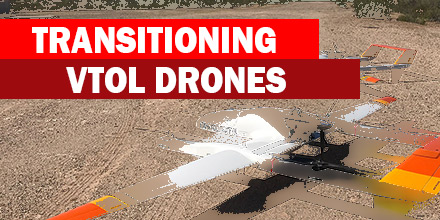
Recently, MicroPilot announced that their autopilot now supports transitioning VTOL drones.
MicroPilot autopilots already fly a wide range of UAVs, including: fixed-wings, multi-rotors, helicopters and even tail sitters.
Now, manufacturers of transitioning UAV drones have the option of a professional autopilot known for its reliability.
Transitioning VTOL Drone Autopilot
Transitioning drones benefit from the many options that come standard with MicroPilot autopilots. The MicroPilot’s HORIZON
mp ground station software features a built-in VTOL simulator. This simulator helps speed up the learning curve and provides an operator training mode.
The MicroPilot’s XTENDER
mp software development kit also enables customers to differentiate themselves from other transitioning drone manufacturers. In addition, MicroPilot’s trueHWIL
2, the highest fidelity simulator in the industry, also supports transitioning drones.
“I’m very pleased that we now have a solution for our customers that want to fly transitioning VTOL drones,” said Howard Loewen, President of MicroPilot. “As the industry matures, high reliability professional products are more important. Manufacturers of transitioning VTOL drones can now choose an autopilot designed with the professional in mind.”
Why MicroPilot?
Drone manufacturers choose professional grade autopilots to ensure high quality and reliability. MicroPilot’s professional grade autopilots are subject to 100% environmental stress screening. In addition, they also go through multi-point calibration and testing during the manufacturing process. This ensures that all of MicroPilot’s autopilots offer consistent performance and outstanding reliability.
By supporting transitioning drones, MicroPilot demonstrates its ongoing efforts to support a wide range of UAV. MicroPilot continues to adapt to the constant changes of an increasingly high-tech world. As new UAVs appear, MicroPilot works to ensure customers have the option of choosing a high-reliability autopilot.
About MicroPilot
Started in 1994, MicroPilot is the world leader in professional autopilots for UAVs and drones. An ISO 9001 certified autopilot manufacturer, MicroPilot markets single-board autopilots, enclosed autopilots, and a triple redundant autopilot. MicroPilot offers a family of lightweight UAV autopilots that can fly fixed wing, transitional, helicopter, and multirotor UAVs.
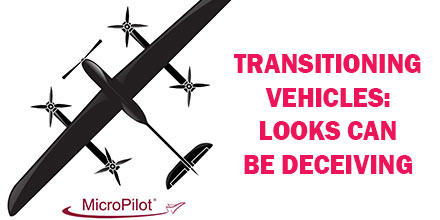 Transitioning UAVs, which combine fixed-wing aircraft with a multi-rotor, seem to be a favored development craft these days.
Transitioning UAVs, which combine fixed-wing aircraft with a multi-rotor, seem to be a favored development craft these days.
 Recently, MicroPilot announced that their autopilot now supports transitioning VTOL drones.
MicroPilot autopilots already fly a wide range of UAVs, including: fixed-wings, multi-rotors, helicopters and even tail sitters.
Now, manufacturers of transitioning UAV drones have the option of a professional autopilot known for its reliability.
Recently, MicroPilot announced that their autopilot now supports transitioning VTOL drones.
MicroPilot autopilots already fly a wide range of UAVs, including: fixed-wings, multi-rotors, helicopters and even tail sitters.
Now, manufacturers of transitioning UAV drones have the option of a professional autopilot known for its reliability.
 MicroPilot recently announced the successful interface of SightLine Applications’ landing assist functionality with MicroPilot’s autopilots.
This new functionality gives integrators the option of a robust landing assist feature. As such, it helps reduce operator workload and training requirements. This feature rolls out in version 3.7.1016 of MicroPilot’s HORIZONmp software.
MicroPilot recently announced the successful interface of SightLine Applications’ landing assist functionality with MicroPilot’s autopilots.
This new functionality gives integrators the option of a robust landing assist feature. As such, it helps reduce operator workload and training requirements. This feature rolls out in version 3.7.1016 of MicroPilot’s HORIZONmp software.
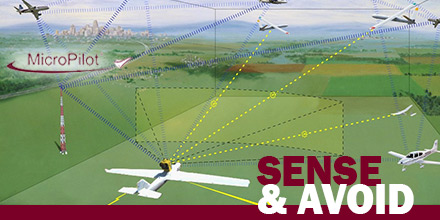 MicroPilot announced the successful integration of FLARM’s Sense and Avoid system with its autopilot.
This integration grants clients a reliable autonomous collision avoidance option for fully autonomous UAV operations.
With any form of autonomous vehicle, a primary concern is safely avoiding collisions with other craft...without the need for human intervention.
A sense and avoid system allows a UAV to do exactly that. Thus, it dramatically reduces operational risks and the need for human monitoring.
MicroPilot announced the successful integration of FLARM’s Sense and Avoid system with its autopilot.
This integration grants clients a reliable autonomous collision avoidance option for fully autonomous UAV operations.
With any form of autonomous vehicle, a primary concern is safely avoiding collisions with other craft...without the need for human intervention.
A sense and avoid system allows a UAV to do exactly that. Thus, it dramatically reduces operational risks and the need for human monitoring.
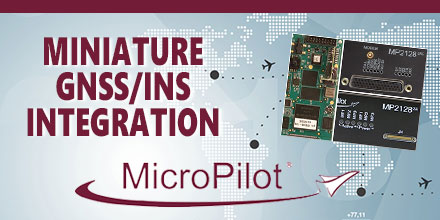 MicroPilot recently announced the completion of work to integrate an OxTS xNAV miniature GNSS/INS system in to their UAV autopilots.
The interface allows MicroPilot systems to use the blended GNSS/IMU output of the INS in their flight control system. This integration provides accurate positioning.
“We were excited to work together with MicroPilot to develop an interface between our systems," said Iain Clarke, Product Manager from OxTS. "As the UAV market continues to grow people are still discovering ways to take advantage of the platform. We hope this development brings new opportunities to customers looking for integrated systems and UAV navigation options.”
MicroPilot recently announced the completion of work to integrate an OxTS xNAV miniature GNSS/INS system in to their UAV autopilots.
The interface allows MicroPilot systems to use the blended GNSS/IMU output of the INS in their flight control system. This integration provides accurate positioning.
“We were excited to work together with MicroPilot to develop an interface between our systems," said Iain Clarke, Product Manager from OxTS. "As the UAV market continues to grow people are still discovering ways to take advantage of the platform. We hope this development brings new opportunities to customers looking for integrated systems and UAV navigation options.”
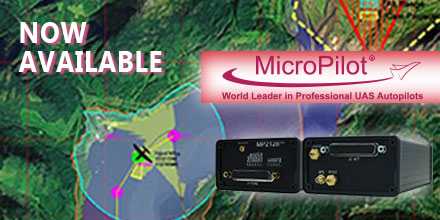 April 4, 2017 – Unmanned Systems Source is pleased to announce a new distribution partnership with MicroPilot, producers of full-featured UAV autopilots.
“MicroPilot is a world leader in small autopilot systems for UAS,” said Drew Osbrink, Business Development Director for Unmanned Systems Source.
"The MicroPilot product line is a great fit for customers looking for a reliable solution to manage complex autonomous behaviors for their UAS platforms,” said Osbrink.
Introduced in 2004 and weighing only 28 grams, MicroPilot's MP2x28g2 raised the bar around the world for functionality and value in small UAV autopilots. Paired with this full-feature UAV autopilot, the MicroPilot HORIZONmp ground control software provides a user-friendly, point-and-click interface for mission planning, parameter adjustment, flight monitoring, and mission simulation.
Building on the success of these proven innovations, MicroPilot now offers a series of autopilots, software, accessories, and customized UAV training and integration services.
April 4, 2017 – Unmanned Systems Source is pleased to announce a new distribution partnership with MicroPilot, producers of full-featured UAV autopilots.
“MicroPilot is a world leader in small autopilot systems for UAS,” said Drew Osbrink, Business Development Director for Unmanned Systems Source.
"The MicroPilot product line is a great fit for customers looking for a reliable solution to manage complex autonomous behaviors for their UAS platforms,” said Osbrink.
Introduced in 2004 and weighing only 28 grams, MicroPilot's MP2x28g2 raised the bar around the world for functionality and value in small UAV autopilots. Paired with this full-feature UAV autopilot, the MicroPilot HORIZONmp ground control software provides a user-friendly, point-and-click interface for mission planning, parameter adjustment, flight monitoring, and mission simulation.
Building on the success of these proven innovations, MicroPilot now offers a series of autopilots, software, accessories, and customized UAV training and integration services.
